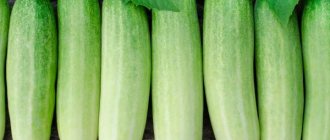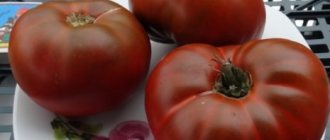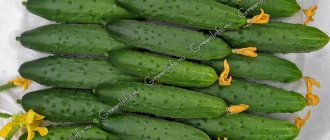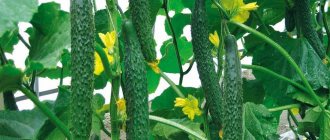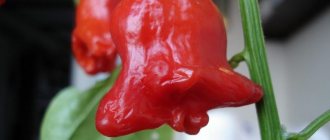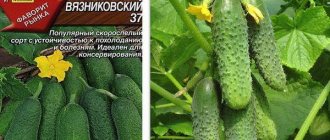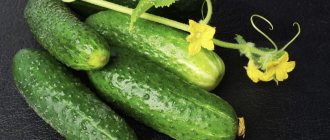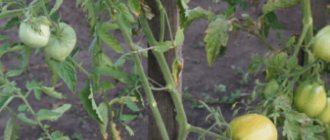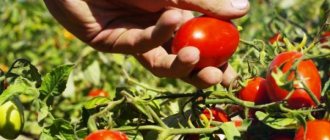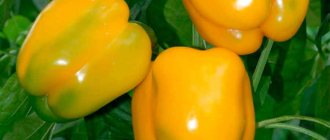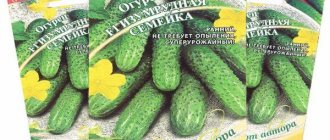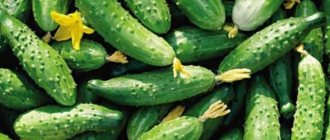Mama's favorite f1 is a parthenocarpic cucumber hybrid variety, that is, it has the ability to self-pollinate. Such fruits have seeds, but the plant itself does not have empty flowers. Thanks to its hybrid properties, it bears fruit equally in the greenhouse and outdoors. The variety was bred in 1994 by Dutch breeders. It grows well in the southern regions, but is also popular in other places. They are chosen for their high yield, bright taste and appetizing fruits. The peculiarity of the hybrid is its undemandingness to growing conditions. It grows well even on a windowsill.
Characteristics of the bush and foliage
The bush is determinate, that is, low-growing. Grows in width rather than in height. The maximum height is 50-55 cm. The bush reaches this size 3-4 weeks after planting in open ground and stops growing. There are not very many leaves, but they are densely spaced, so the plant looks lush. The leaves arranged in this order do not shade the plants and do not interfere with their development.
Note! The leaves are heart-shaped, 15 cm wide at their widest point. The color of the leaves and stem is dark green.
The leaf has white or yellowish veins. During the flowering period, the resulting buds are light yellow. The ovaries appear in a fascicle type. There are up to seven ovaries in the leaf axils. The leaves, shoots and stems are almost completely smooth; hairs are rare.
The thickness of the stem is 1-1.5 cm, so it is quite stable and can withstand heavy cucumber fruits. When forming a bush, it can grow vertically - in a greenhouse and horizontally in open beds.
Type – small gherkins. These vegetables look appetizing and attractive to eat. An early ripening vegetable - no more than 45 days should pass from planting in the ground to harvesting the first fruits.
Characteristics of cucumbers:
- The weight of a ripe fruit reaches 90 g, but rarely rises higher. Fruits weighing more than 100 g are considered overgrown. They lose their taste and become watery.
- The length of an adult, fully ripened fruit does not exceed 10-12 cm.
- The shape is elongated, the cucumbers are of medium thickness. They look very neat and attractive.
- The color changes from bright to dark green. The ribbing of cucumbers is average.
- Pimples are rare, but located quite close to each other.
- Young cucumbers also have sharp white thorns.
The taste of cucumber is sweet, bitterness almost never appears under the right care conditions. When cut, the seeds are almost invisible. The pulp is almost completely white. There are no voids due to which a false volume is created. The vegetable is dense and hard. The peel is thin.
The Mamenkin Lyubimchik variety does not have a clearly defined culinary purpose. It is definitely suitable for a variety of purposes. Pickled and pickled cucumbers turn out well, the variety goes well with other vegetables, so pickled salads with cucumber are delicious. Gherkins retain their crunch and taste even during long-term storage and in marinade - the main advantage of the variety. The excellent appearance of the product makes it a welcome guest on any table.
Growing Requirements
Before sowing on ridges in open ground, it is recommended to soak the seeds for several days, which will speed up the emergence of seedlings. It is necessary to plant seed material in moistened, moderately loose soil, which must also be warmed to a depth of 10 cm. The seeds should be buried no more than 3-3.5 cm.
In weather and climatic conditions in the Moscow region, it is recommended to sow seeds in greenhouses no earlier than mid-April. When grown on beds with temporary film cover, prepared seeds are sown in the last ten days of April. Sowing in open ground can be done in mid-May. In the middle zone of our country, hybrid cucumbers “Mama's Favorite” are recommended to be sown at the end of May on warm ridges with the crops covered with film.
A good result is obtained by growing cucumber seedlings, the age of which at the time of planting should not be less than 25-30 days. Plants should be planted at a distance of 0.9 m from each other and approximately the same distance between rows.
Basic care consists of watering, fertilizing, loosening and weeding. The use of a mulch layer will help maintain soil moisture and also help suppress the growth of weeds.
Productivity and Benefits
Cucumber Mama's f1 favorite is considered a high-yielding variety. Up to 7.5 kg of tasty fruits are harvested from one bush per season. From 1 m2 – up to 15 kg of harvest. Such a large number of fruits makes the variety suitable for sale and homemade cucumber preparations. Growing such a high-yielding variety is a profitable business, given the variety’s unpretentiousness in care and cultivation conditions.
Advantages compared to other types of cucumber:
May be interesting How to spray cucumbers with hydrogen peroxide: rules and terms of application Cherry “Iput” variety description Tasty grapes for central Russia - reality
- Great taste. Sweet, pleasant taste makes this species a welcome guest on the table.
- High yield. Compared to other varieties, this species bears much more fruit. To collect almost 8 kg of finished crop from just one bush is a lot.
- Versatility in cooking. Pickling, salting, preparing canned foods, fresh salads - the list of culinary uses is huge.
- Versatility of growing locations. It grows well in a greenhouse and outdoors. Chernozem soils, clayey and loamy soils are suitable for it. The variety quickly adapts to any growing conditions.
- Self-pollinating. For this reason, you can grow such cucumbers in a greenhouse or even on a windowsill.
There are also disadvantages. Despite all the unpretentiousness in growing conditions, the pet definitely needs the sun. This is what affects the taste of the cucumber and the lack of bitterness in the peel.
Attention!
It is better if the cucumber is exposed to the sun throughout the day. Therefore, in cloudy summers, vegetables turn out small and inconspicuous.
When choosing a variety, first of all they pay attention to whether the gardener has suitable growing conditions.
Mama's favorite cucumber. Stage VI. Test results
I am summing up the results of testing and sharing my impressions of the wonderful cucumber Mama’s Favorite F1 from the breeding and seed company Gavrish . When I was choosing cucumbers for testing, I first of all paid attention to their resistance to disease, since downy mildew is a frequent visitor to me. So Mama’s favorite is precisely resistant to downy mildew and root rot.
From the description of the variety
Early ripening (43-48 days from germination to fruiting) parthenocarpic hybrid for growing in open and protected ground. Valued for its high yield of delicious crispy pickles and aromatic gherkins for canning and barrel salting. Zelentsy up to 8-10 cm, weighing 80-95 g, strong, with large tubercles, black-thorned. 3-7 ovaries are formed in each sinus.... A very productive hybrid, bears fruit from June to mid-September, sweet, crunchy, aromatic! The yield exceeded even that declared, but the hybrid is a pickling hybrid, and its skin is tender only in infancy. Despite this quality, I am simply fascinated by this hybrid, it is no coincidence that the name was coined Mama’s Favorite !
Ads by
Germination test and sowing
When checking germination, I soaked the seeds on April 19,
germination was 100%, on April 20 all the seeds sprouted and were planted in containers.
Seedling development
The shoots appeared on April 23, and on April 24 I put the boxes in the greenhouse for peppers, as the cucumbers began to stretch.
To protect from the bright sun and nighttime drops in temperature, I installed arcs and covered them with spunbond.
The first true leaf appeared on May 1st,
photographed on May 3. Water the tray with warm water so that the soil in the containers does not become compacted.
Planting in a greenhouse
The soil in the greenhouse has warmed up, and at the time of planting, the cucumber seedlings have grown a little and already have 3-4 true leaves.
I planted it in a greenhouse on May 15, sprinkling each hole with ash and adding a spoonful of Gumi fertilizer.
Flowering and appearance of the first ovaries
Planted in a film greenhouse, the seedlings took root well, and on May 26 the first flowers opened.
I saw the first ovaries on June 5th.
I calculated that 44 days passed from the moment of germination until the appearance of the ovaries (6-8 cm), this exactly corresponded to what was stated in the description of the hybrid!
Fruit collection, fruit characteristics
The first harvest was collected on June 9.
Total weight 928 g.
Zelentsy 9-10 cm long,
The weight of the cucumber is less than stated - 55 g.
The tubercles are large, the thorns are black, the cucumber is sweet and crisp.
I partially pinched the side shoots, leaving 2-3 ovaries, and chose 4 plants from which I would harvest separately and weigh them throughout the entire fruiting period. I marked them with plastic spoons.
For harvesting, I made partitions in a shoe box and numbered them.
I picked cucumbers small, I don’t like overgrown cucumbers, for me the optimal cucumber length is 8 cm.
To know exactly which cucumber harvest is shown in the photo, I placed a piece of paper with the name of the variety and the plant number near the scales.
The cucumbers had to be removed often; as soon as they outgrew, the ovary in the bunch dies.
The more greenery I removed, the faster new ones grew. I collected small cucumbers for preservation, and larger cucumbers were used for salads.
The weighing results were recorded in a table, noting the date of collection, the number of fruits from each plant and the weight of these fruits.
I'm testing Mama's favorite cucumbers. June (cucumber harvest).
| Cucumber No. | 9.06 | 11.06 | 16.06 | 19.06 | 26.06 | 28.06 | Result in June | |||||||
| Col. | weight | Col. | weight | Col. | weight | Col. | weight | Col. | weight | Col. | weight | Col. | weight | |
| №1 | 5 | 232 | 5 | 230 | 4 | 758 | 4 | 698 | 5 | 232 | 5 | 258 | 28 | 2408 |
| №2 | 5 | 232 | 5 | 230 | 5 | 800 | 4 | 674 | 5 | 228 | 4 | 238 | 28 | 2402 |
| №3 | 5 | 232 | 5 | 230 | 4 | 630 | 5 | 806 | 8 | 332 | 5 | 298 | 32 | 2528 |
| №4 | 5 | 232 | 5 | 230 | 6 | 680 | 2 | 416 | 5 | 537 | 6 | 359 | 29 | 2454 |
At first, two cucumbers grew in the sinuses, then three or more. Mommy's favorite. July (cucumber harvest) Testing cucumbers Mama's favorite. Aug. Sept. The tables were not completely removed during the post, I could barely figure out how to place them! The September cucumbers have grown to the roof of the greenhouse, there are still a lot of ovaries, but the vines are already running horizontally, blocking out the sun.
Result
Cucumbers are Mommy's favorite. From June 9 to September 2 the following were collected: Cucumber No. 1 – 152 pcs., weight 9414 g Cucumber No. 2 – 150 pcs., weight 9207 g Cucumber No. 3 – 164 pcs., weight 9644 g Cucumber No. 4 – 164 pcs. weight 9608 g Average quantity 157 pieces, average weight from one bush - 9468 g. At the beginning of September, the nights became cold, and the cucumbers began to grow more slowly, the last harvest that I weighed was 1051 k from four bushes on September 6.
I did not include it in the table, since the vines began to intertwine with each other at the top, and it became difficult to determine from which bush the cucumber was taken.
And after a few days, general weighing became impossible, since the cucumbers were completely intertwined with each other under the roof of the greenhouse.
From this batch of cucumbers,
filmed on September 6, I made two jars of canned cucumbers in tomato juice.
This was the last canning of cucumbers. With the arrival of cold nights, signs of downy mildew appeared.
On September 15, the greenhouse began to be cleared of plants.
Conclusion
Mama's favorite cucumber fully confirmed all the characteristics declared by the manufacturer. Parthernocarpic, multi-beam hybrid, very high yield and excellent taste, long fruiting period, little susceptible to disease (signs of the disease appeared only at the end of August), universal use. Summing up the testing, I would like to thank the breeding and seed production company Gavrish and the administration of the 7 Dachas site for the opportunity to test this hybrid.
Pollination and variety diseases
The Mama's Favorite f1 cucumber is characterized by the ability to self-pollinate. This occurs due to wind, moisture, and the simultaneous presence of a queen and a stamen in the flower. For parthenocarpic varieties, the main principle of existence is the optimal ratio of drought and moisture, temperature balance. Parthenocarpic cucumbers traditionally have denser, bushier foliage.
In general, this variety is characterized by increased resistance to viruses, diseases and unfavorable conditions. The immune system is strong. However, despite resistance to various viral diseases, there are some strains of diseases that the variety may find difficult to cope with. The most dangerous diseases:
- Powdery mildew. It is characterized by the appearance of white spots, similar to flour, on the back of the sheet. As the disease develops, it gradually affects the entire plant - the spots spread to the outer side of the leaf, the stems and finally to the roots. There are effective remedies for the disease, but they only help if the symptoms of the disease are detected in a timely manner: colloidal sulfur, Thiovit Jet, Fitosporin-M.
- Downy mildew. Pale yellow spots that turn into dark brown and purple as the plant develops. Topaz helps with it.
- Alternaria blight. With this disease, white ulcers appear on the leaves and stems. It is impossible to completely get rid of the disease. In fact, you can only hide the symptoms that appear so that they do not spread to the fruit.
- Anthracnose. The most dangerous disease of all, as it manifests itself in the decay of all elements of the plant. First, the leaves, stem, shoots, and then the roots die. It is almost impossible to save the plant.
Dangerous pests for this variety are aphids and miners. To prevent their occurrence, it is recommended to apply a decoction of onion peels to the root. To combat existing pests, it is necessary to use insecticides. Fitoverma is one of the most versatile options.
Note!
Among the unfavorable conditions for the development of this variety are drought, lack of sunlight and stagnation of air in the soil.
It is important to organize proper watering, access to the sun (if the weather permits) and loosening the soil.
Growing and care
The beds need abundant, but not excessive watering every 3-4 days. It is better to carry it out in the evenings or early mornings, using settled warm water. The water temperature should be about +24-26 degrees. For 1 sq. m will require approximately 5 liters, but in hot weather and during the fruiting period the rate is increased.
The bushes are fed 3-4 times, the first time two weeks after planting the seedlings or when 2 true leaves appear on the seedlings in open ground. Add 50 g of wood ash per square meter of bed or carefully water it under the root with a 1:4 solution of manure. Solutions are also effective:
- potassium sulfate – 40 g of the drug per 2 buckets of water;
- nitrophoska – 30 g per two buckets of water;
- ammophoska (it is applied to the soil next to the cucumbers, pouring the dry preparation into the grooves along the rows - an average of 2 tablespoons per row).
The soil is regularly loosened and weeds are removed.
Features of agricultural technology of the variety
There are two ways to plant the Mama’s Favorite variety – seedlings and seeds directly into the ground. To grow seedlings, soil and seeds are purchased separately in advance. To disinfect the soil, add 10 ml of potassium permanganate to it. Drainage is laid out in advance at the bottom of the growing container. Cover everything with soil on top and leave it to rest for 24 hours.
Before directly planting seeds:
- Moisturizes the soil well.
- The seed is placed in a hole specially created for the seed, 1 cm deep, and sprinkled with earth.
- Cover the seedlings with film on top.
When the first shoots appear, carefully monitor soil moisture and temperature conditions. It is optimal to moisten the soil not with water pressure from a watering can, but with a spray bottle. The temperature of the liquid for irrigation should not be hotter than 30 °C.
Two to three weeks before planting seedlings in open ground, they must be hardened off. To do this, just take the plant outside or open the windows. The duration of hardening in the first days is 8 minutes, then gradually increase to 20.
When the seedlings have their first leaf, they need to be fed with nitrogen-containing fertilizers. The optimal time for transplanting into the ground is when the temperature during the day does not drop below 20, and at night - below 15 for several days.
Sowing hybrid seeds
The seed fund is first disinfected using a weak solution of potassium permanganate, aloe juice or honey. After this, the seeds are germinated until roots appear. The largest specimens are selected and then planted in separate peat cups. Water with warm water. Feed with complex fertilizers or organic matter.
Grown seedlings are transferred to open ground at the end of May. When planting seeds in a greenhouse, this period shifts to the end of April. When planting in beds, it is necessary that the air temperature during the day does not fall below +22 °C. If there is a danger of the night temperature dropping below +16 °C, then it is recommended to cover the bushes with warm material in open areas, and install heating devices in greenhouses without heating.
Mommy's favorite loves warmth and good lighting. Therefore, for planting, you need to choose places where there are no drafts. The format for planting bushes is 0.5 X 0.5 m.
At home, this hybrid is planted on window sills, balconies, and loggias. In such conditions, cucumbers grow all year round, if the soil is not waterlogged, there are no drafts, and there is normal lighting. For bushes grown at home, drying out of the soil poses a great danger. The plants begin to get sick and produce little fruit.
Rules of care
Plants need to be watered 2-3 times a week with warm water standing in the sun. Moderate volumes of liquid are used. You need to make sure that water does not get on the leaves, otherwise the bushes will get burned, and this will affect the harvest. In case of severe drought, increase the frequency of watering - do it every day.
To prevent plants from shading each other, it is recommended to remove all leaves that interfere with neighboring bushes. Cucumbers must be fertilized at least 4 times per season. First, organic fertilizers (manure, peat, chicken droppings) are used. Then add some nitrogen and potassium mixtures. During flowering, the bushes are given more phosphorus fertilizers.
If the farmer has complex mixtures containing nitrogen, potassium and phosphorus ingredients, the hybrid can be fed 3 times per season. Initially, this operation is carried out 10 days after planting the seedlings in the ground. The following fertilizing is done during flowering and fruit formation.
It is recommended to loosen the soil for better aeration of the root system of cucumbers 2 times a week. This measure will speed up the growth of bushes and eliminate the threat of destruction of plant roots by root parasites.
Weeding will prevent the hybrid from becoming infected with certain diseases caused by fungal and bacterial infections. This procedure is carried out once every 12-15 days. At the same time, some pests die, which settle on weeds and then move on to cultivated plants.
The gardener must carefully monitor the appearance of various garden pests on the site. If dangerous insects are found, they are exterminated using chemicals or traditional methods of plant protection.
The plant is recommended to be grown in the Northern, Central, North-Eastern regions of the country, including the Vyatka and Middle Volga regions. The cucumber bush is not tall. Height between medium height and short height. There are few leaves, they are medium in size and do not shade the ovary. The color of the plate is bright green. The ovaries grow in bunches, each containing 3-5 flowers. There are bunches with 7-8 buds. Flowering according to the female type. Inflorescences are rich, yellow.
Most fruits grow on the main stem. They are distinguished by their early ripeness; after 45 days the plant begins to bear fruit. The indicator can vary up to 43 to 48 days. Designed for cultivation in open and closed ground. The main purpose of the culture is salting and canning. But people also eat them fresh and use them for salads.
Characteristics of the cucumber fruit Mama's favorite:
- They are small in size and belong to the gherkins.
- The length of a ripe fruit is 80-100 mm and weighs 70-90 g. In rare cases, green fruit can reach 120-130 g.
- Neat shape, weak ribbing.
- The color is light green, some vegetables are dark green.
- Thorns with white thin pubescence. Some specimens are observed to be black.
- There is no pattern on the fruits, but there are stripes of white and whitish shades at the beginning and end of the fruit.
- Medium density peel.
- There is no seed chamber.
The pulp is soft, juicy, and has no voids. When bitten, a characteristic aroma is felt. Bitter fruits are rare due to improper care.
Cucumbers are the most popular vegetable crop. With the onset of the season, gardeners try to plant it early in order to taste the fragrant fruits of their labors at the beginning of summer. The Mama's Favorite variety belongs to the hybrid group. It is distinguished by its unpretentiousness to climatic conditions and resistance to common diseases characteristic of representatives of the pumpkin family. The variety is intended for cultivation in greenhouses and open ground.
Plants need to be watered 2-3 times a week with warm water standing in the sun. Moderate volumes of liquid are used. You need to make sure that water does not get on the leaves, otherwise the bushes will get burned, and this will affect the harvest. In case of severe drought, increase the frequency of watering - do it every day.
Cucumber Mama's Favorite F1 is an easy-to-care universal hybrid, the harvest of which can be obtained both in open ground and in a greenhouse. It has tasty and aromatic greens, equally well suited for salads and for preparations.
- Watering. Vegetable crops are very sensitive to soil moisture. In dry weather, it is recommended to water every other day. For irrigation use warm, settled water. The manipulation should be carried out in the evening or in the morning before sunrise. Water consumption is approximately 5-6 liters for one square meter of planting. Leaves and shoots should not be allowed to get wet. During the beginning of flowering during the fruiting period, water consumption increases. For cucumbers, it is preferable to choose drip irrigation.
- Loosening. After watering, it is recommended to loosen the soil so that an earthen crust does not form on the surface. Loosening is carried out with care so as not to damage the root system of plants. In addition, this will help enrich the root system with oxygen. In parallel with loosening, weeds must be destroyed. Weeds take nutrients from the soil and also carry dangerous viruses.
- Feeding. After the sprouts appear, organic fertilizers must be applied. Stove ash or chicken droppings are suitable for this purpose. During flowering and fruiting, mineral nutrient mixtures should be added. Fertilizers are applied along with watering at the roots and spraying the plants. Procedures should be carried out after sunset.
Methods for growing a hybrid
Since Mama’s Favorite f1 cucumbers are bred for growing in indoor and outdoor areas, as well as at home, there are many ways to grow them:
- growing in open beds;
- on a balcony or loggia;
- in a greenhouse under temporary shelter;
- in a closed greenhouse.
Outdoor cultivation involves sowing seeds and caring for growing plants.
Before sowing, the seeds are disinfected, soaked for germination and planted in the ground. The planting period is different in different regions, but weather conditions must be suitable for this variety. So, daytime air temperature should not drop below 22 degrees, and nighttime below 16 degrees. If this condition is met, delicious cucumbers will definitely grow in the beds.
Plants are planted in the greenhouse earlier, at the end of April, beginning of May, provided that the night frosts have passed. If frosts are still expected, it is better to play it safe and heat the room where the seedlings are growing using a heater.
At home, cucumbers are planted on the windowsill all year round. Since this plant is heat-loving, it is necessary to prevent drafts, waterlogging or drying out of the soil, and provide access to lighting to the plants, otherwise the seedlings will get sick and develop poorly.
READ MORE: Step-by-step cultivation of cucumbers in a barrel, photos and useful tips || Growing cucumbers in a barrel step by step with photos and videos
Landing
Cucumbers can be grown in seedlings or without seedlings.
When choosing a site in the open ground, you should give preference to sunny places, protected from drafts, but making it possible to stretch a special shading net over the bushes in intense heat. The best predecessors for cucumbers are beets, potatoes, tomatoes, peppers, cabbage and legumes, but they cannot be sown after other pumpkin crops.
In the fall, the site is dug up and fertilized with manure or compost. In the spring, seeds are sown when the soil temperature is at least 14-15 degrees. For 1 sq. m plant 3-4 bushes. Before the seeds germinate, the soil is covered with film.
Seeds are sown for seedlings in April using peat pots and a nutrient substrate. It is grown on a sunny windowsill for 25-30 days.
Description of the fruit
Gherkin fruits are small. An adult fruit weighs only 90 grams and is 8–10 centimeters long. The cucumbers are neat, light green in color, slightly ribbed. The entire surface of the fruit is covered with sharp white spines. On the flower side there are light stripes that do not reach the middle of the fruit. The taste is sweet; when cut, the fruit does not have a seed sac or voids. With proper watering and feeding, the cucumber does not taste bitter.
The fruits are suitable for universal use - they can be pickled, salted, or used fresh. Also, Mama's favorite is often used for growing on an industrial scale, due to its keeping quality and resistance to transportation over long distances.
Variety label
Breeders got this hybrid when they crossed 2 different varieties. There are few leaves in the bushes, so they do not interfere with the access of light. The age of fruiting begins 45 days after sowing the seeds. The bushes are characterized by limited growth and a small number of shoots. The inflorescences are tied in bunches. For ease of harvesting and inspection, plants affected by diseases or pests are tied to an installed vertical trellis.
The item is self-pollinating, perfect for growing at home. The plants are characterized by a woman's type of flowering, so the variety is distinguished by high yields.
Feedback from lovers who planted Mama's favorite
Nina: “In winter, I decided to grow cucumbers on the windowsill, after reading reviews from gardeners, I bought the seeds of Mommy’s favorite. I planted it before the New Year. In February, the whole family ate cucumbers. The greens are tasty and small in size. The main requirement of this variety is proper care and watering, as well as creating conditions at home suitable for growing cucumbers. I’ll plant them in the garden in April and see how they behave there.”
With proper care, Mama's favorite will give a good harvest when planted in any place.
